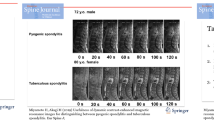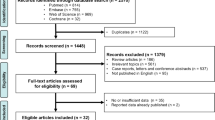Abstract
Background. Tuberculosis (TB) of the spine is the most common site of osseous involvement and has a higher prevalence in developing nations with an increasing incidence in developed nations. There are few paediatric reports of TB spondylitis (TBS) that include MRI findings.
Objective. To determine the MRI characteristics of TBS in children with special reference to gadolinium enhancement and findings on follow-up MRI.
Materials and methods. A retrospective review of patient records and MRI scans by three readers using a consensus method of 53 patients below 13 years of age.
Results. Seventy-nine percent presented with kyphosis. MRI showed thoracic involvement in 83%. Eighty-five percent showed contiguous involvement of two or more vertebral bodies. An intraspinal or paraspinal soft-tissue mass or abscess was present in 98%. Subligamentous extension was noted in 64% of patients. Gadolinium was administered in 26 patients. Ring enhancement of the soft-tissue mass was shown in 65% of these. Subligamentous enhancement was shown in 35% and bone enhancement was shown in 100% of patients. Follow-up MRI performed in 16 patients showed progressive bone destruction in 10 patients, progressive kyphosis in 2 patients and progression of soft-tissue disease in 4 patients.
Conclusions. We have demonstrated an advanced pattern of TBS in this childhood population, which supports other reports that describe a more aggressive process in children. Kyphosis and cord compressions were the most common complications. The use of gadolinium is promising in detecting disease earlier, as it invariably results in bone enhancement and may assist in making the diagnosis when the rim-enhancing pattern of the soft-tissue mass is demonstrated. Follow-up imaging with MRI is a suitable way of assessing resolution of cord compression and decrease in size of the soft-tissue mass. Therefore, considering the pattern of involvement in children with TBS demonstrated by this study, MRI is considered an ideal modality for making the diagnosis, demonstrating the extent of disease, identifying complications and assessing response to treatment.
Similar content being viewed by others
Author information
Authors and Affiliations
Additional information
Electronic Publication
Rights and permissions
About this article
Cite this article
Andronikou, S., Jadwat, S. & Douis, H. Patterns of disease on MRI in 53 children with tuberculous spondylitis and the role of gadolinium. Ped Radiol 32, 798–805 (2002). https://doi.org/10.1007/s00247-002-0766-8
Received:
Accepted:
Issue Date:
DOI: https://doi.org/10.1007/s00247-002-0766-8




